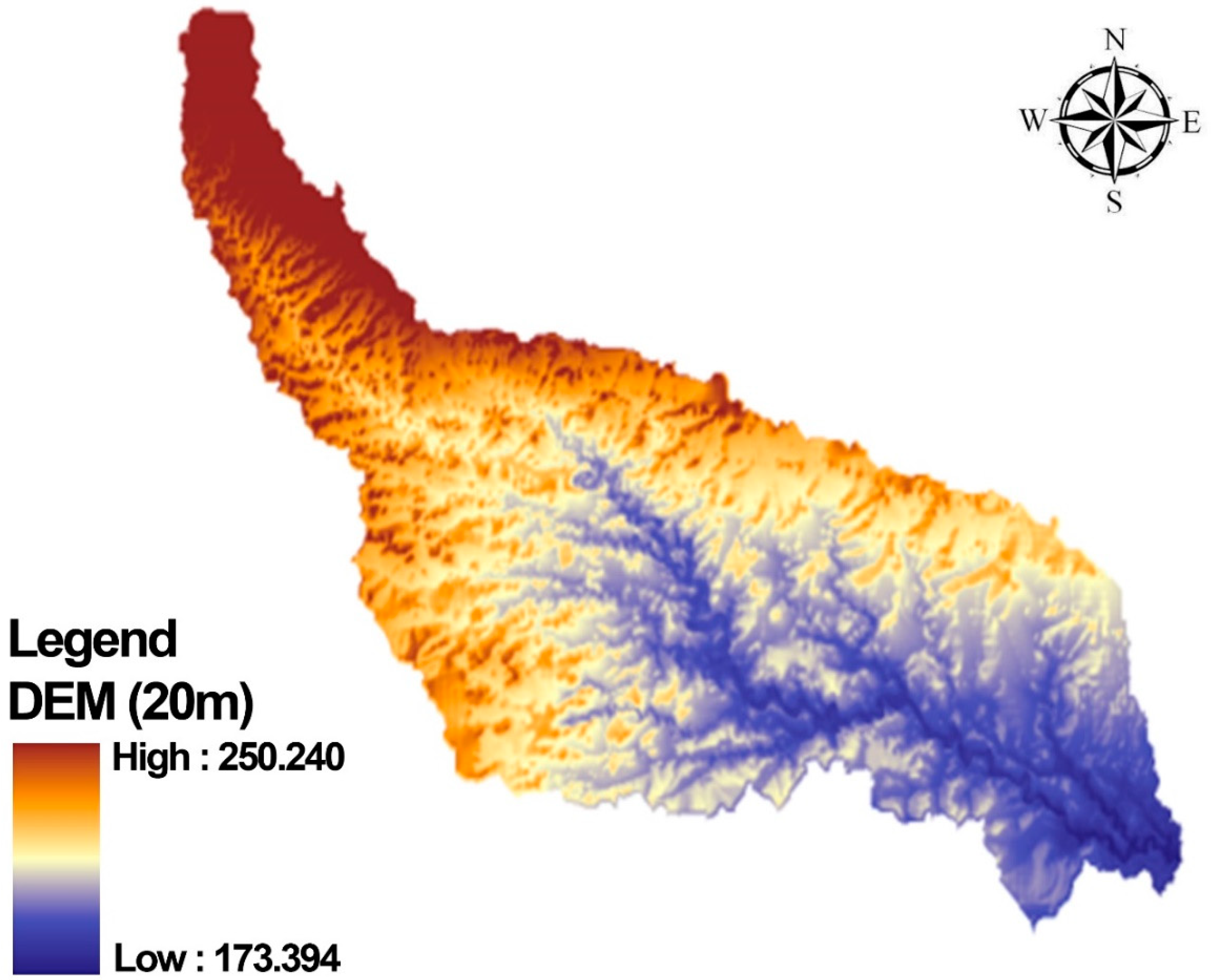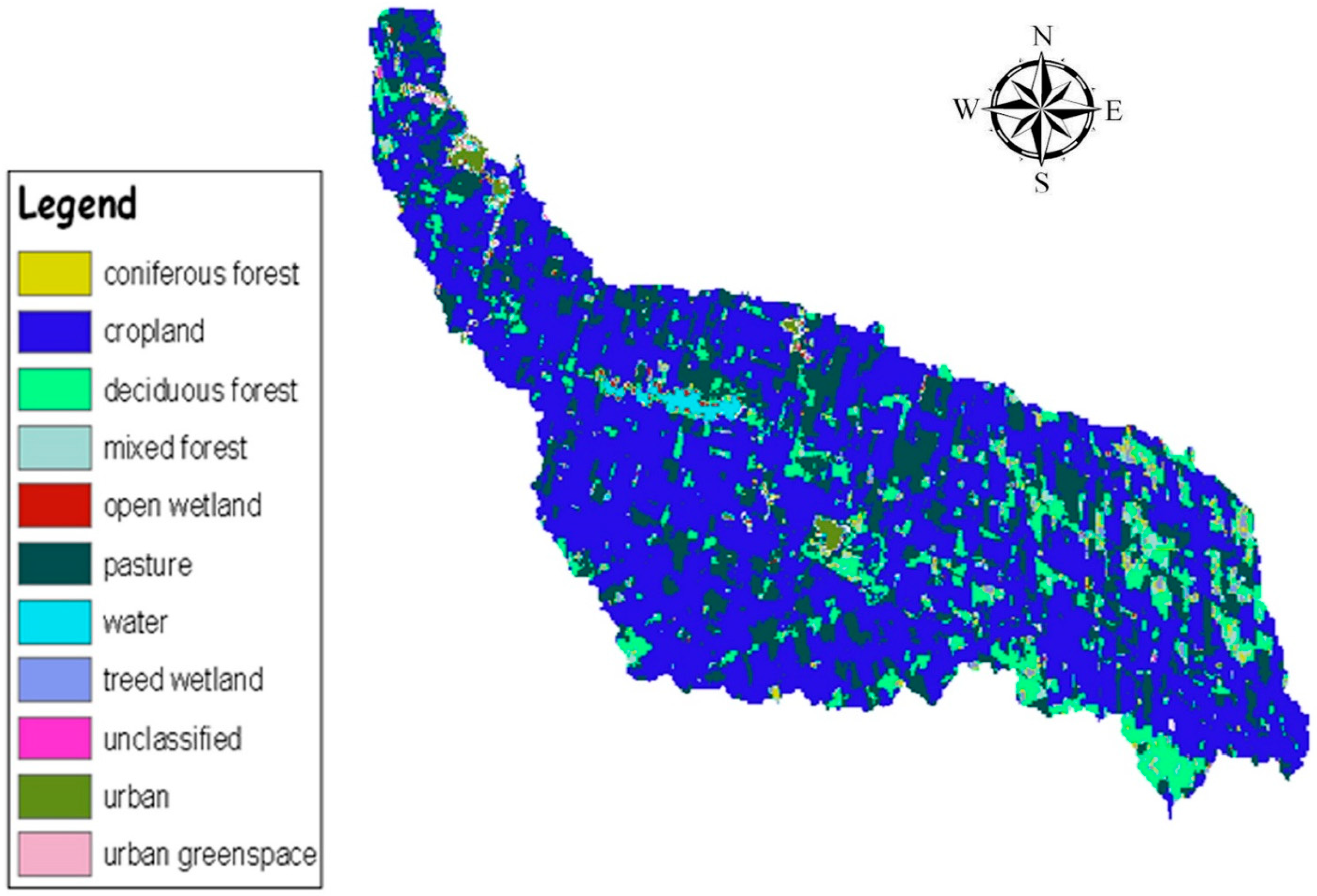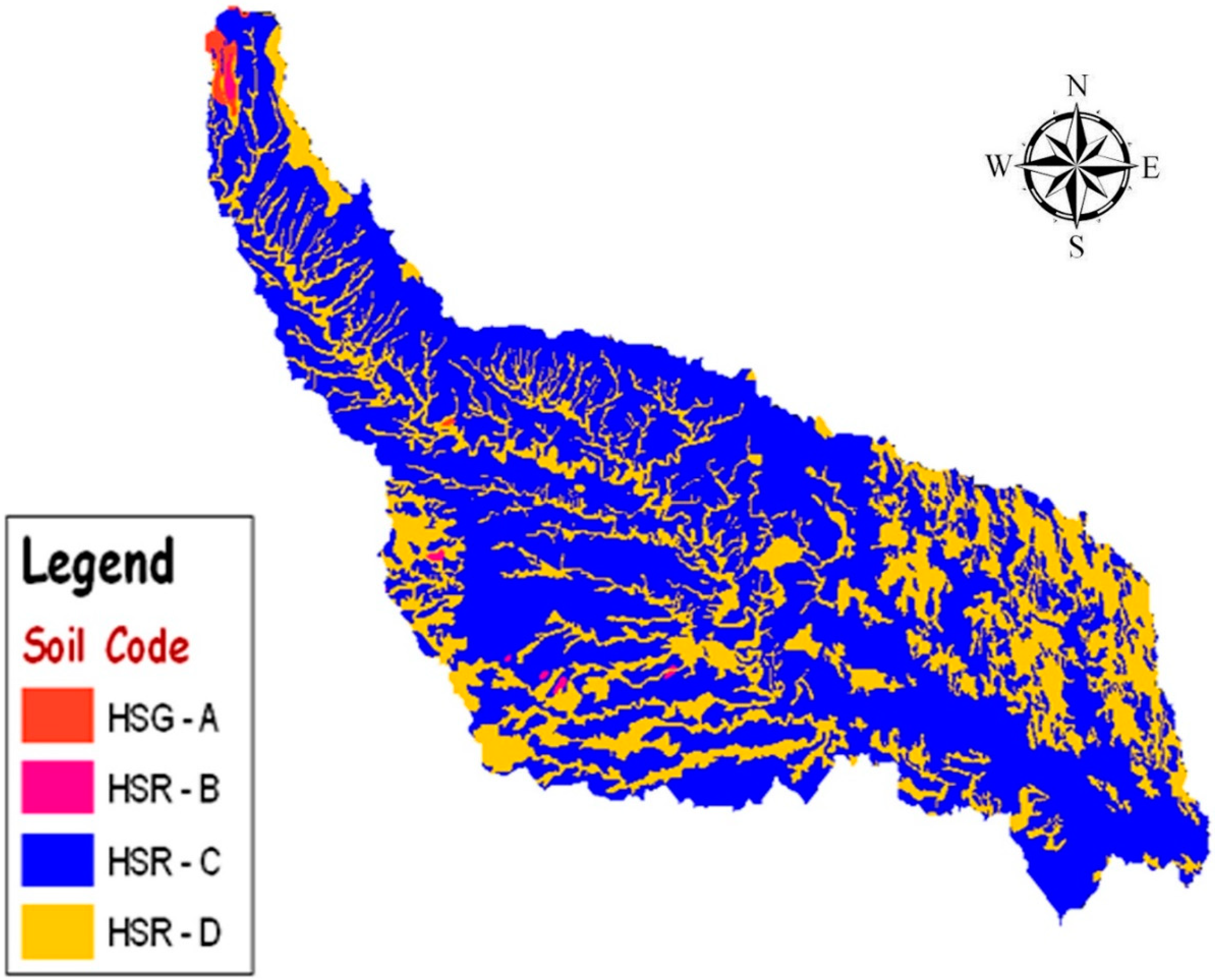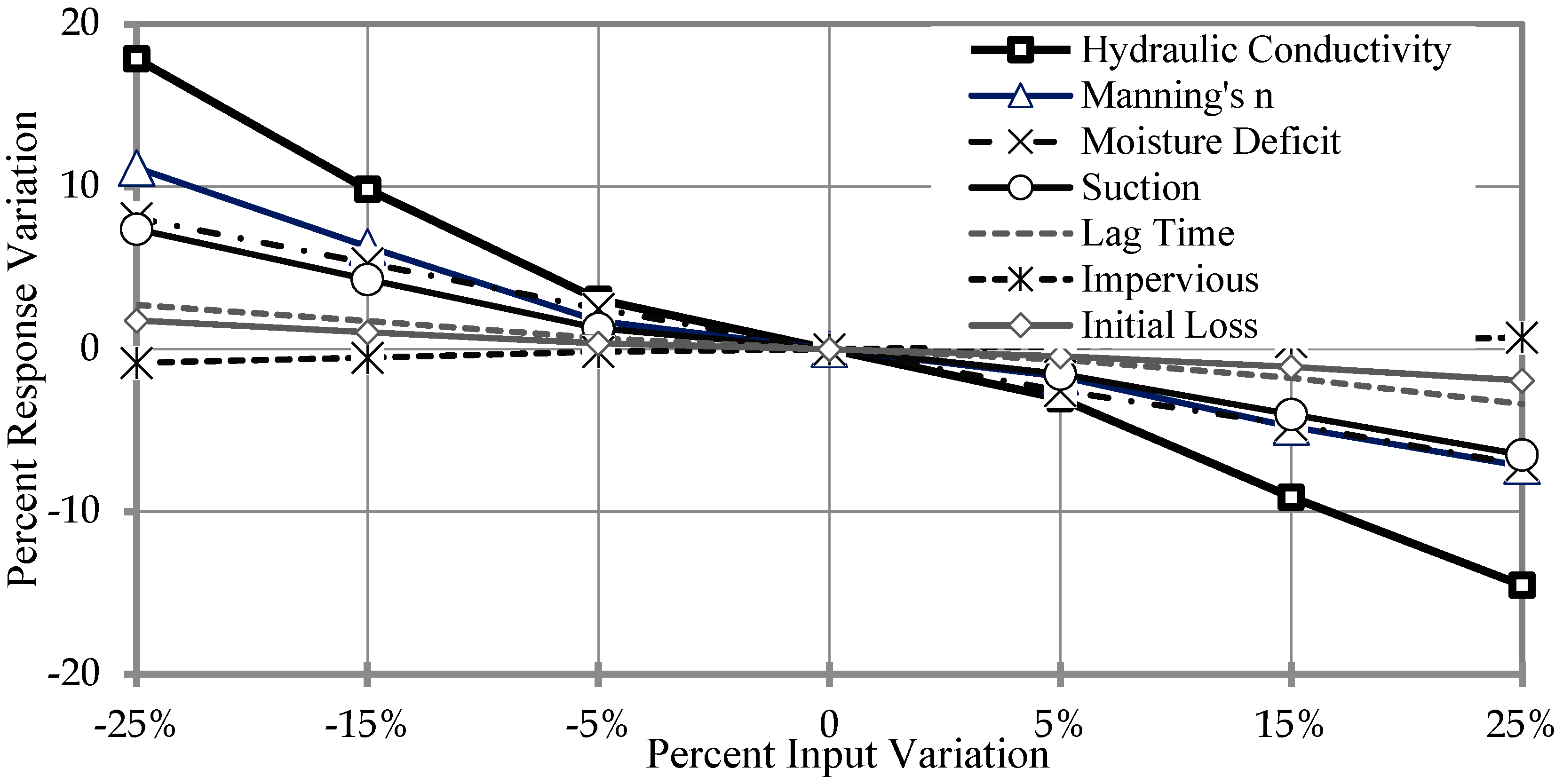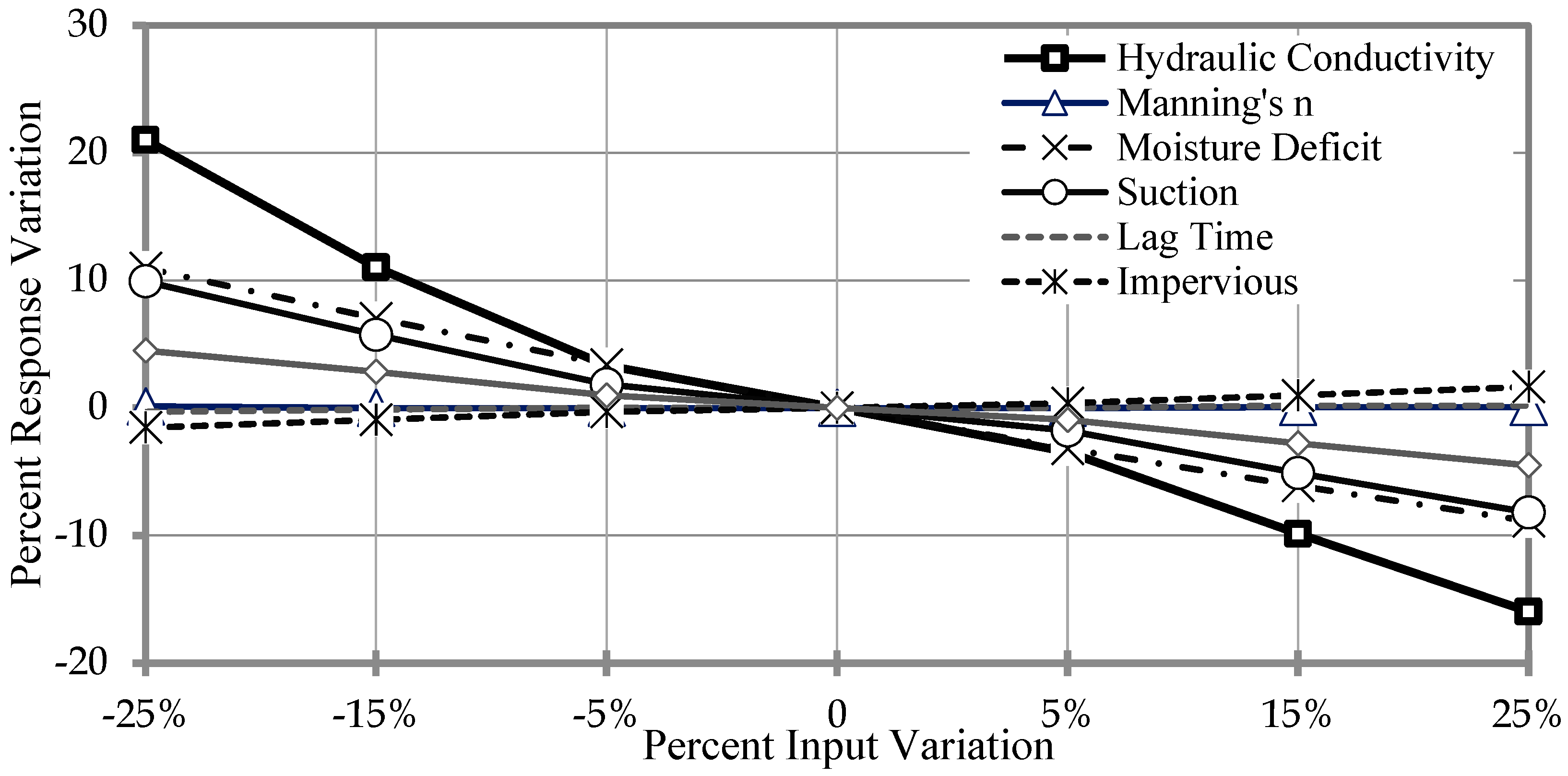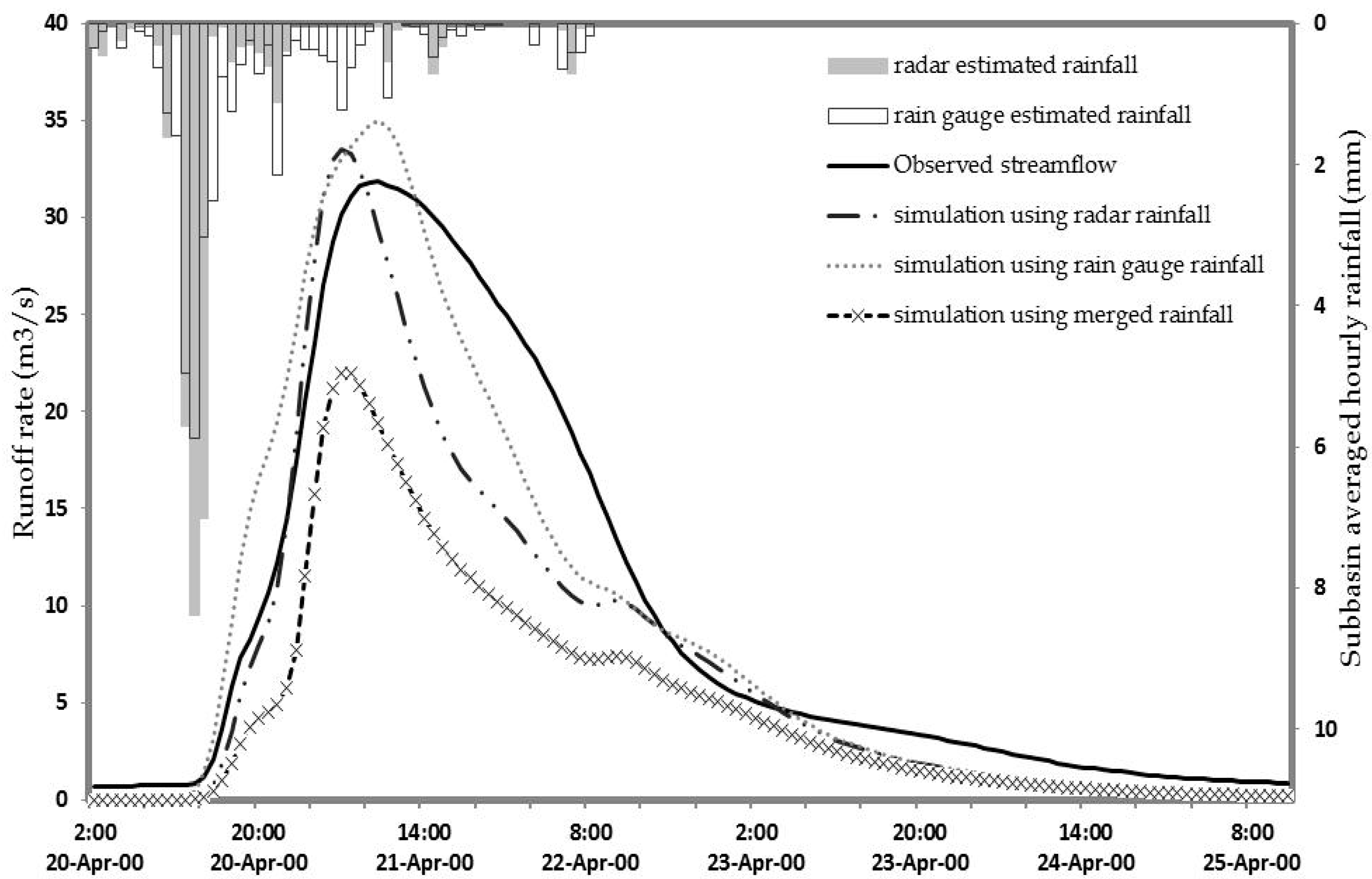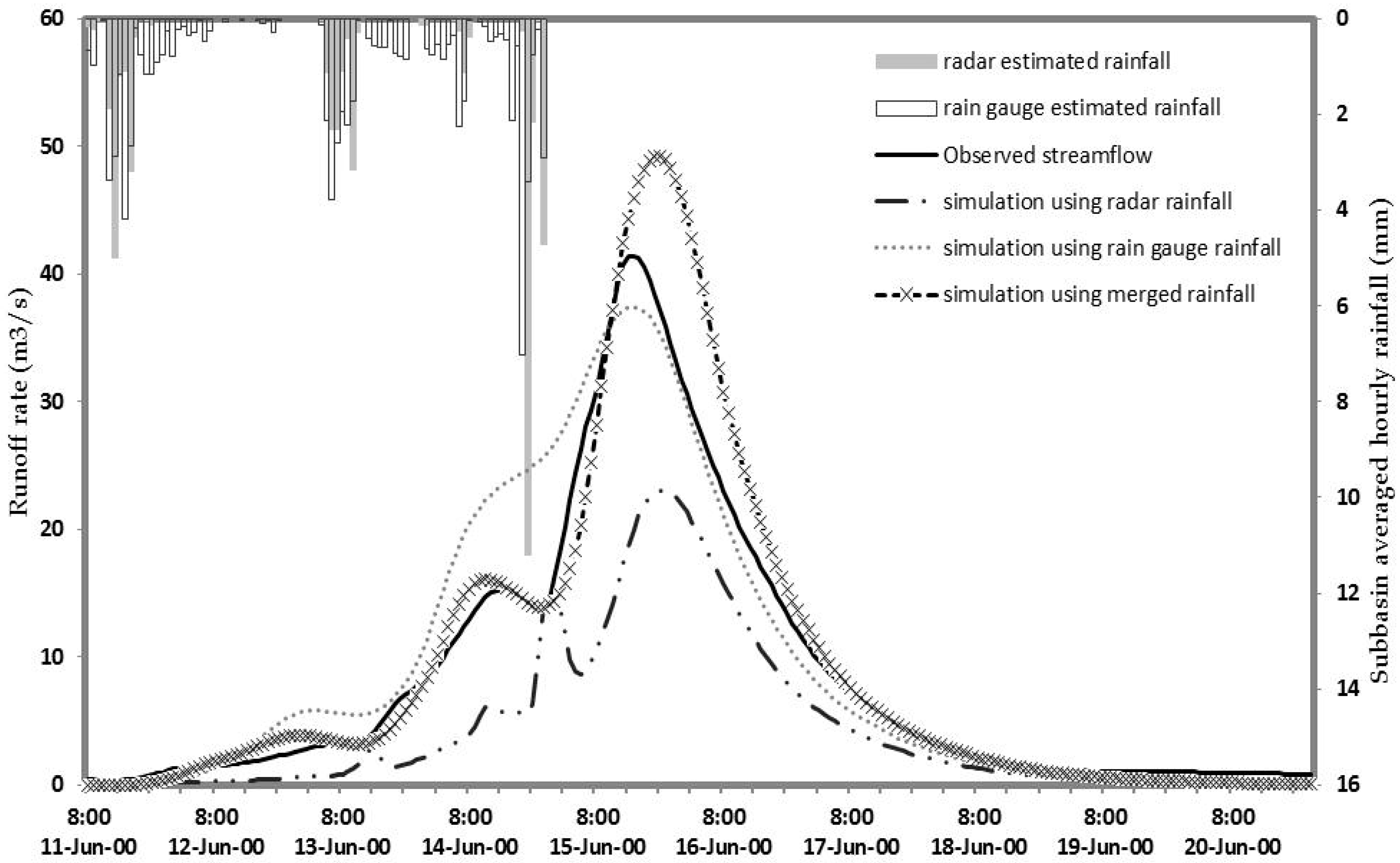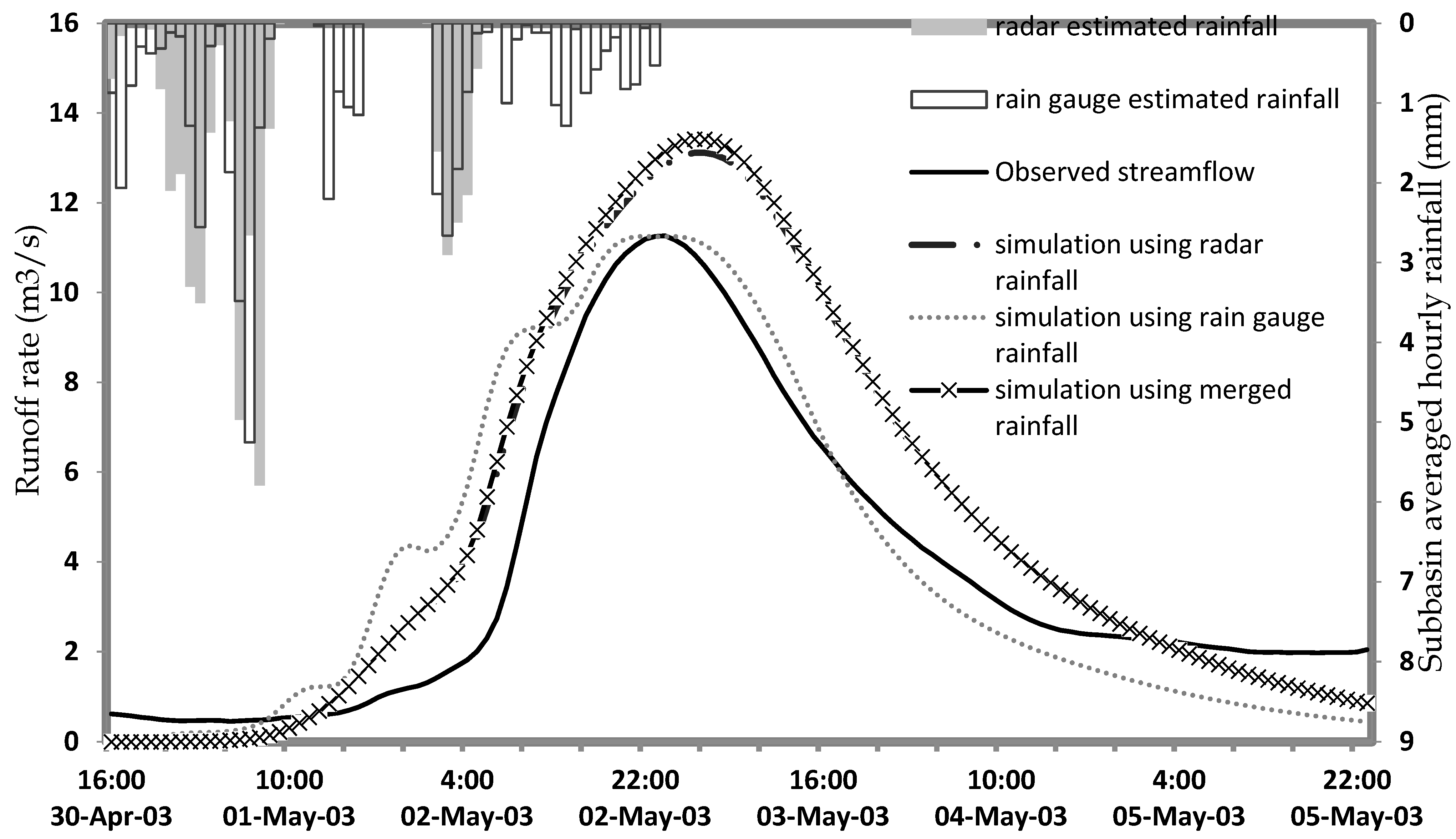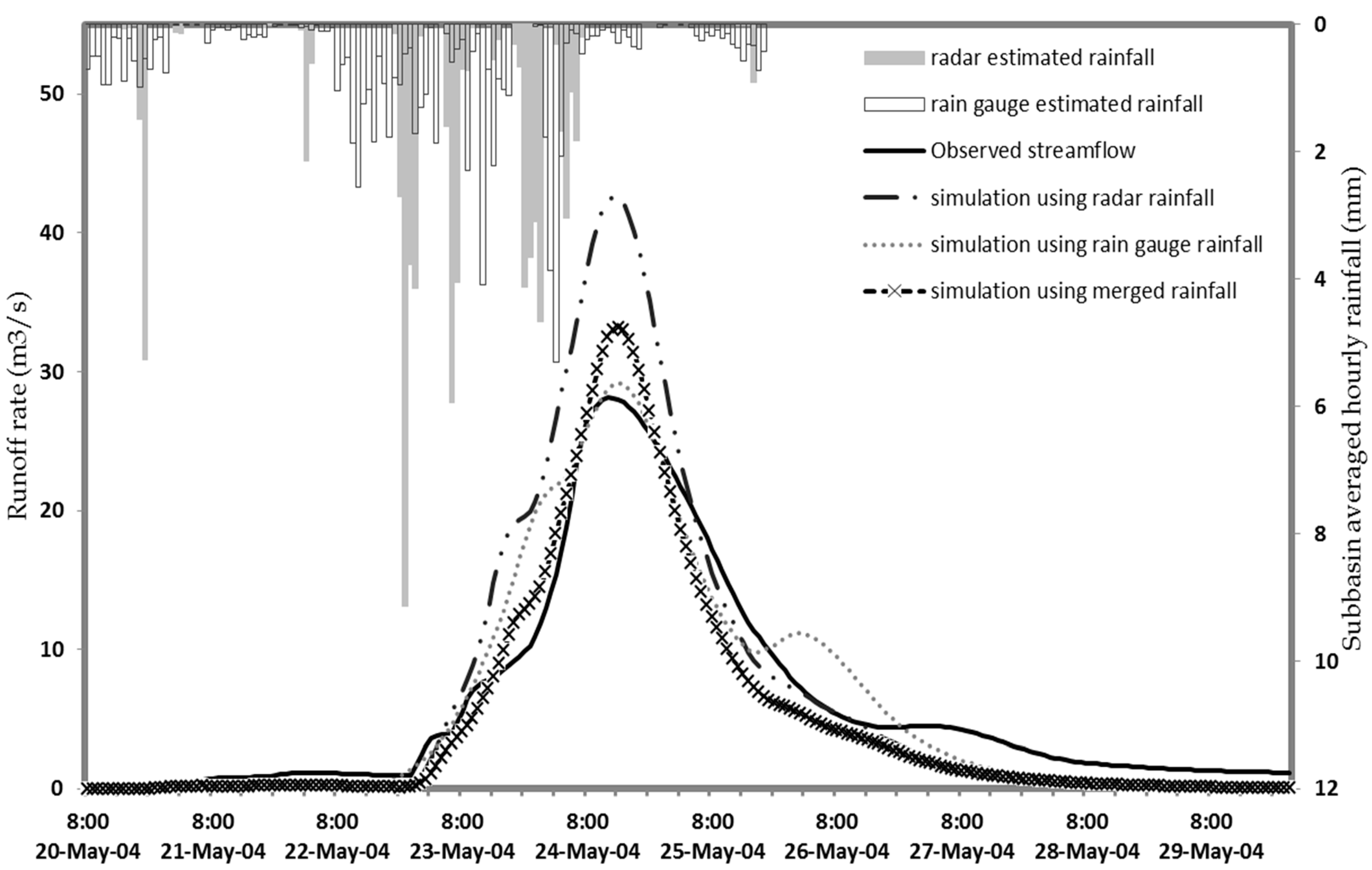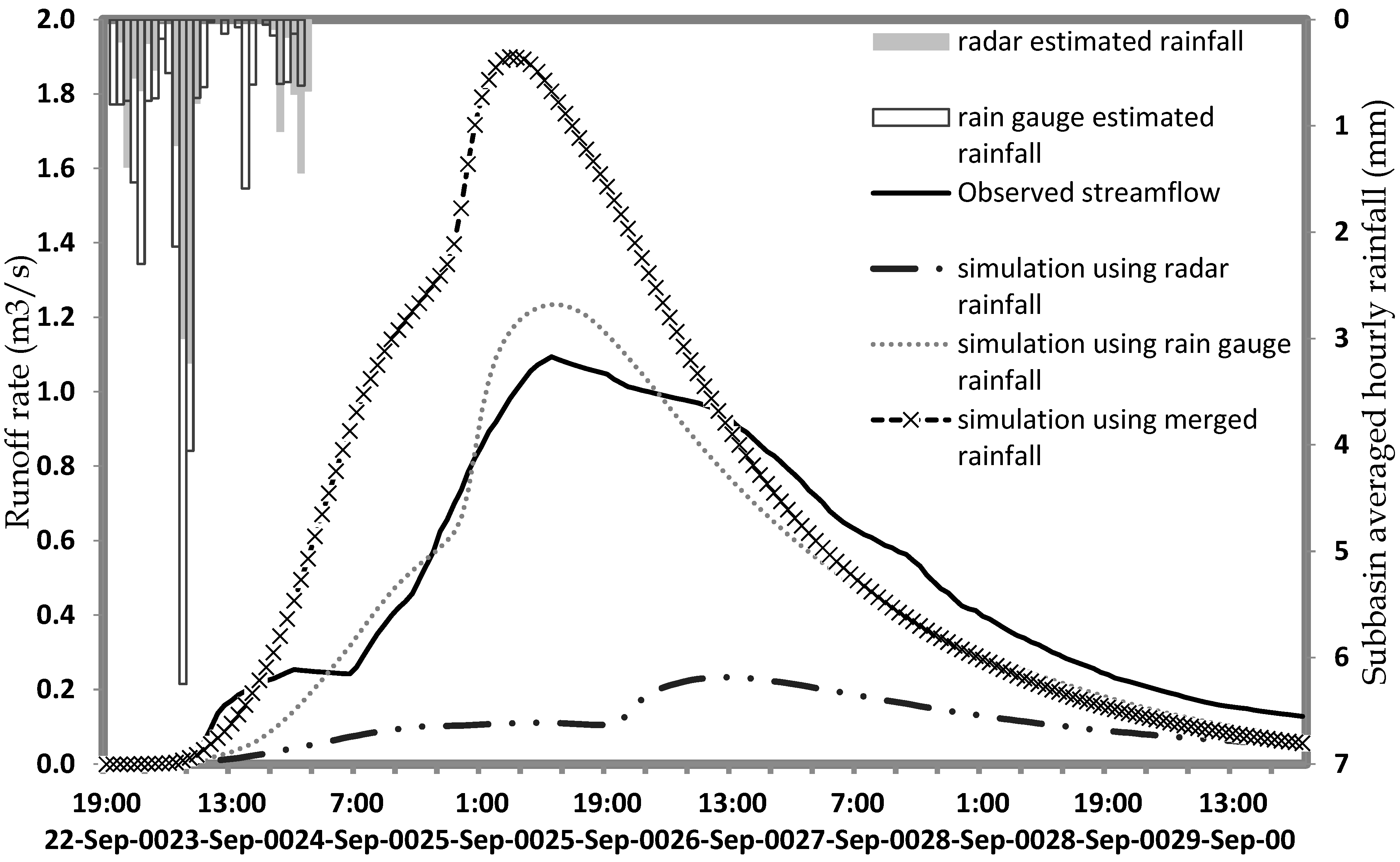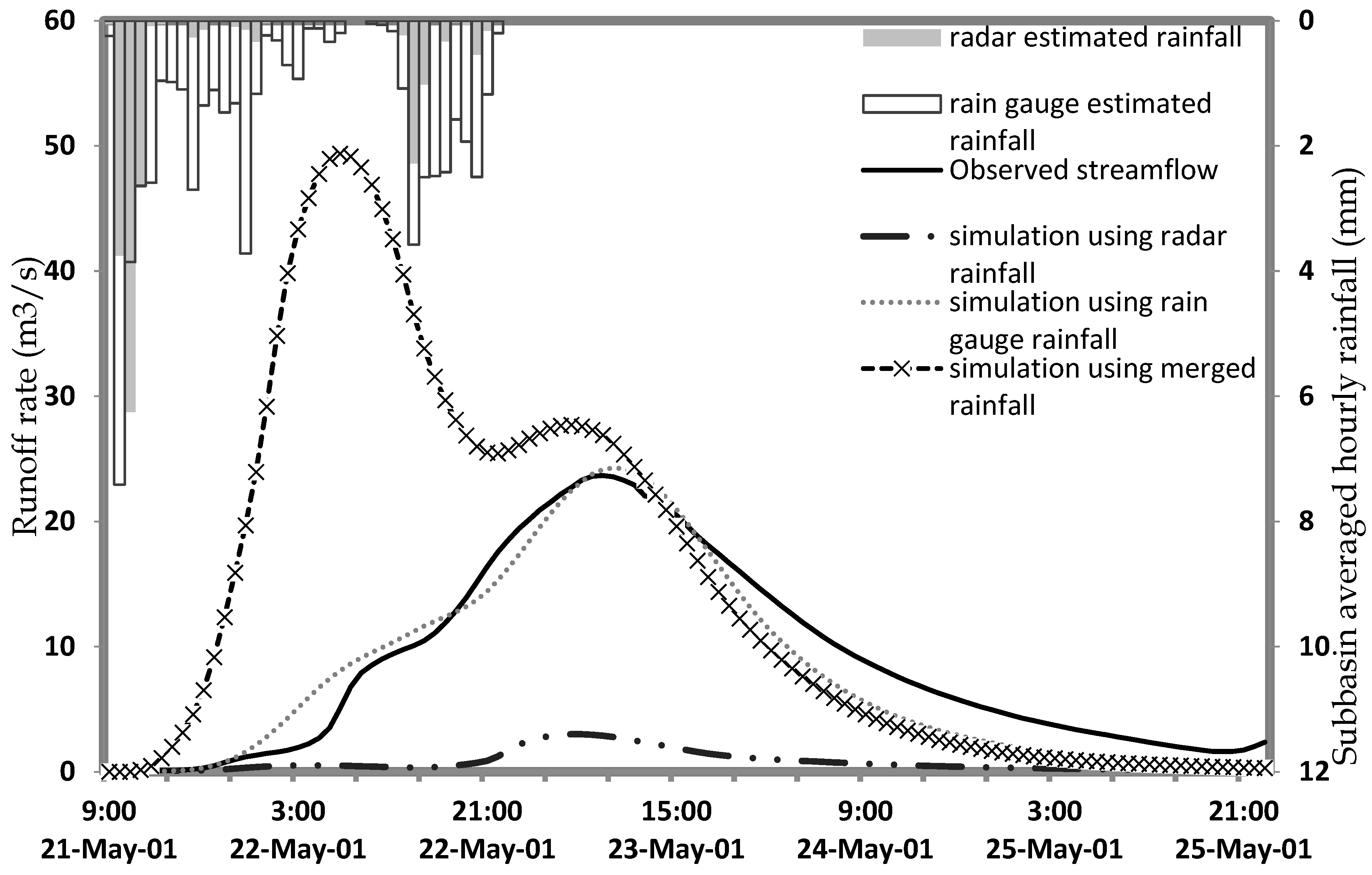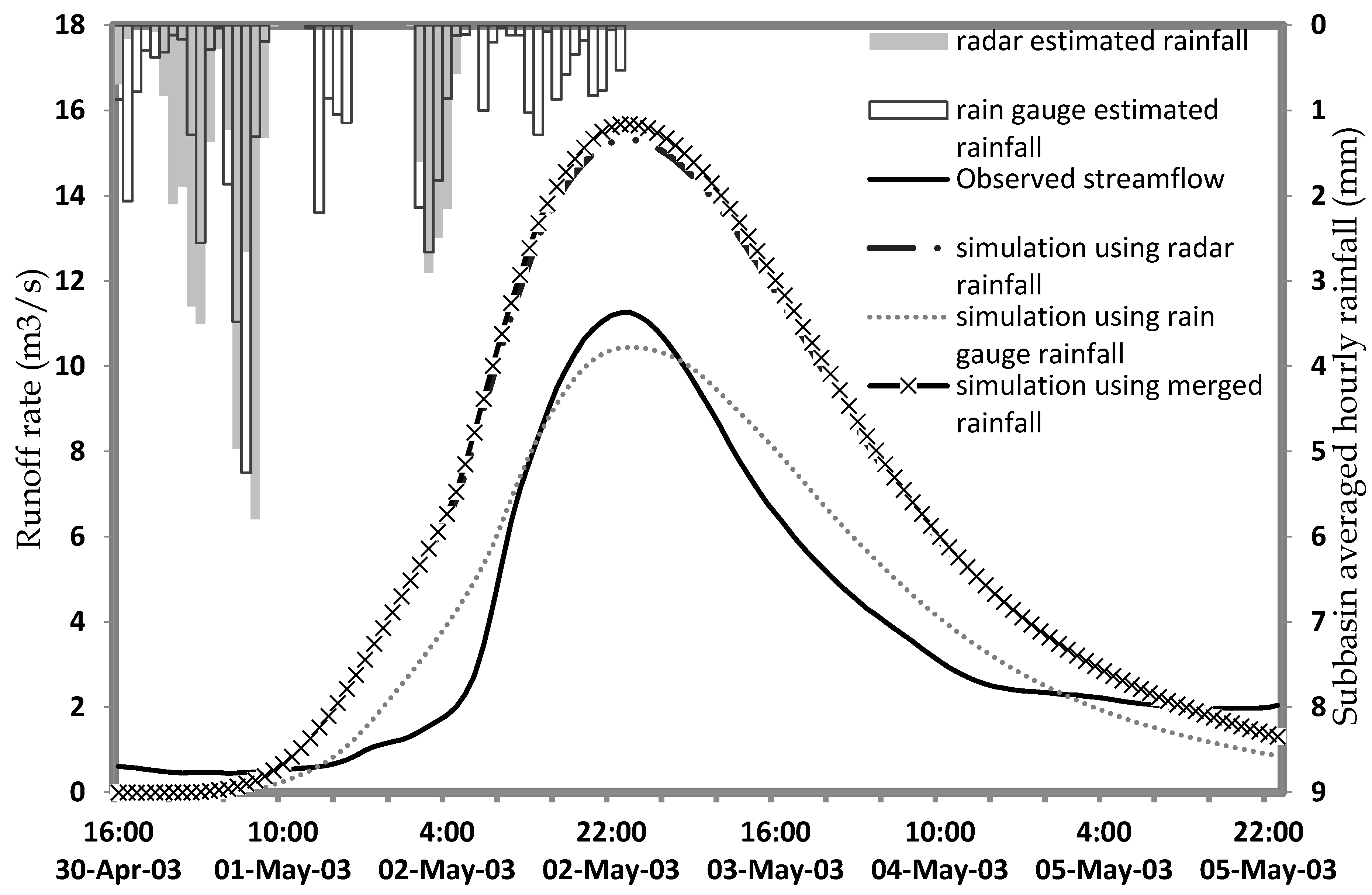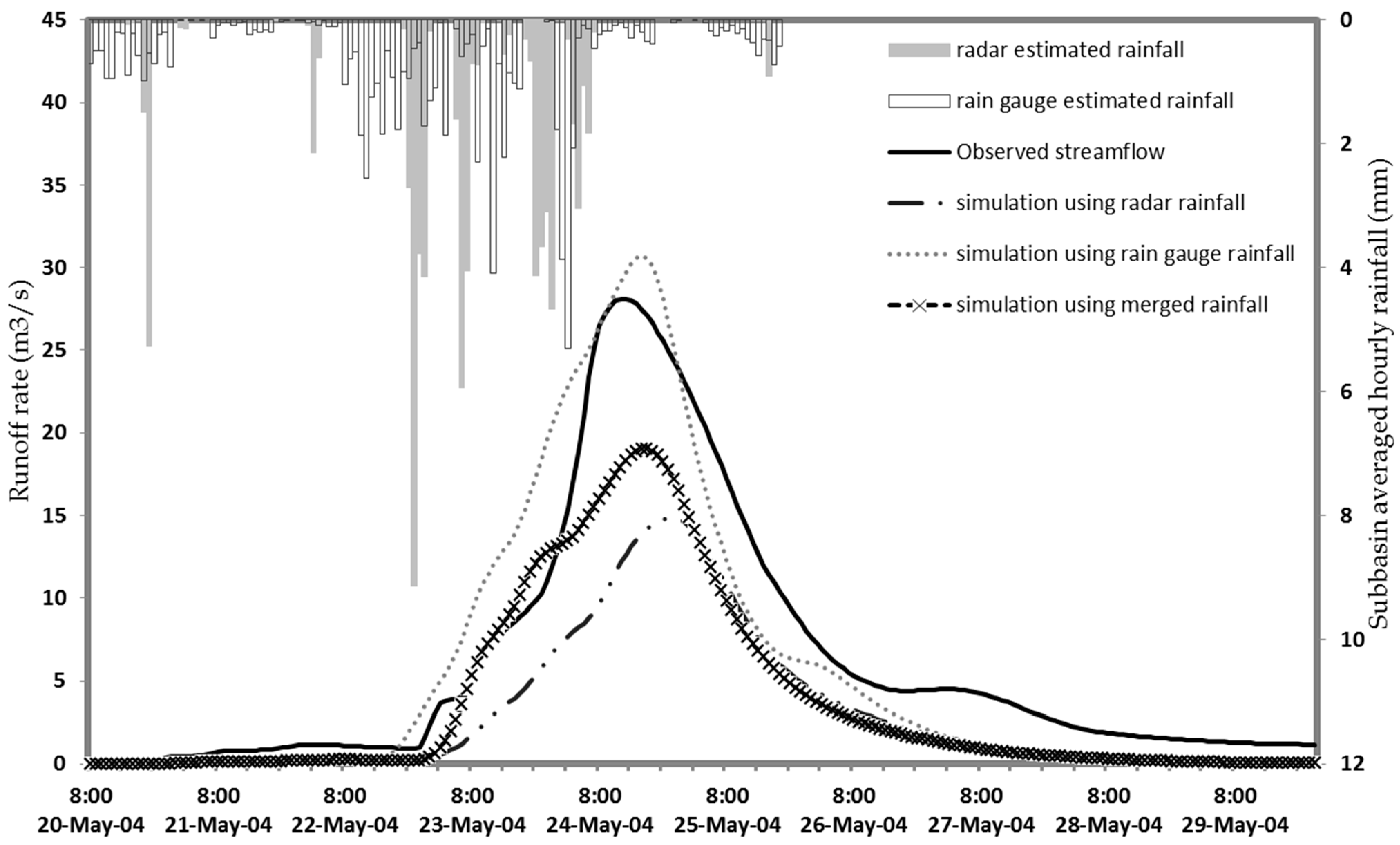1. Introduction
In hydrology, a key factor for accurate flood estimates is to have reliable spatial and temporal measurement of rainfall. Typically, rain gauges and radars are used for the measurement and estimation of rainfall. Rain gauges are generally considered as accurate estimates of precipitation near the ground surface; however, recording the spatial variability of rainfall at the watershed scale is difficult [
1,
2]. The precipitation data are collected by measuring rainfall at the ground using rain gauges, satellite, and weather radar [
3,
4]. Rain gauges provide rainfall measurements for a particular point where the rain gauge is located. Depending on the spatial distribution of rain within the watershed, these point-measurements of rainfall can significantly affect the estimation of streamflow. On the other hand, the radar-rainfall measurement technique can provide the spatial distribution of rainfall with the watershed. The radar detects raindrops by emitting out a pulse of electromagnetic energy from the radar station and then measures the energy reflected from the rain [
5]. GRCA’s study also indicated that the potential of underestimation (most common) and overestimation error exists for the rainfall measurement through radar. Hence, for the reliability of results, estimation through rain gauge and radar needs further development or corroboration. Nonetheless, reports favor radar rainfall technology since a single site can obtain coverage over a wide area with a high temporal and spatial resolution [
6].
Both networks, rain gauge and radar, have some limitations in accurate measurement and estimation of rainfall at the watershed scale. These limitations include a sparse rain gauge network to cover the large watersheds and the difficulty of forecasting rainfall with a longer lead time based on rain gauge data only [
7,
8]. However, radar systems have the ability to observe the spatial variability of rainfall for large areas that can improve the short-term prediction of rainfall for an area. Nevertheless, the accuracy of radar measurements is not up to the mark for extreme rainfall events [
9,
10]. The reason for this low accuracy is that the rainfall intensity is derived indirectly from measured radar reflectivity. As a result, this process results in various sources of error [
11]. In the last few decades, progress has been made to improve the estimation of rainfall based on radar measurements. Many correction methods have been applied to reduce the errors in the radar data [
12,
13], including more recent advances based upon dual-polarization radar measurements [
14,
15,
16,
17].
It is important to note that it is challenging to have accurate radar-estimated precipitation even with the new radar technologies and techniques. This is due to the primary limitation of indirectly estimating rainfall from the radar data—more specifically, away from the radar station and at a higher point above the ground [
1,
18]. In addition, it is also essential to have measured rainfall data to compare them with radar data as a reference before using the data in the modeling work for an area’s rainfall or flood assessment. The characteristics of radar-rainfall estimates for streamflow analysis were determined by Ghimire et al. [
19] for the effect of spatiotemporal radar-rainfall characteristics, radar range visibility, and characteristics of river network topology. The study used Multi-Radar Multi-Sensor and IFC-ZR from the Iowa Flood Center (IFC), USA. The study evaluated 140 USGS gauge stations that monitor rivers in Iowa, using the Hillslope–Link Model. The streamflow prediction showed that the spatial and temporal resolution of rainfall significantly affect the smaller basins (<1000 km
2). It was also found that for larger basins, the significance of rainfall resolution is less effective for streamflow changes.
In general, radar data are inclined to errors due to multiple factors and mostly underestimate the rainfall intensities [
20]. Lau et al. [
21] also mentioned that underestimated radar intensities fed to the flow prediction models are not helpful for urban flooding simulations. Thorndahl et al. [
22] found that most of the urban models are calibrated partially and validated on rain gauge data; therefore, the results may not be so dependable for future predictions. Recently, a study was conducted by Mapiam et al. [
23] in Tubma basin, Thailand, where hourly radar rainfall bias adjustment was applied using two different rain gauge networks: tipping buckets, measured by Thai Meteorological Department (TMD), and daily citizen rain gauges. The radar rainfall bias correction factor was updated using both datasets. Daily data from the citizen rain gauge network were downscaled to an hourly resolution based on temporal rainfall data from radar. The approach showed that an improvement in radar rainfall estimates was achieved by including the downscaled data from rain gauges, especially the areas with scarce rain gauges.
It is a well-known fact that the input of rainfall in a hydrologic model is the key parameter for calculating water balance, water distribution, and flood forecasting in the watershed. Since most of these models were developed on rain gauge data, these data have great significance in hydrologic modeling [
4,
24]. However, these rain gauges have limitations in measuring the spatial and temporal variabilities in the observed precipitation across a watershed [
25]. The radar systems have the capability to record the spatiotemporal change in precipitation at a watershed scale. Since radar produces spatially and temporally continuous data over a large area in real time, there is considerable interest in precipitation information derived from weather radar for a hydrological model run in operational flood forecasting [
4,
26].
Researchers in water resources and related fields have been interested in rain gauge and radar data adjustment since the last century. They referred to the merging of rain gauge and radar due to the use and effectiveness of radar technology in capturing precipitation [
26,
27]. Since then, several merging techniques have been introduced to better predict precipitation and consequently other hydrologic variables by modeling. Some of these methods have proven effective in increasing the accuracy of precipitation data [
18,
28,
29,
30].
A study was conducted by Sapountzis et al. [
31] to assess the use of satellite precipitation data for hydrologic analysis, such as the peak discharge of flash floods in ungauged Mediterranean watersheds. Cumulative precipitation heights from a local rain gauge for Global Precipitation Measurement and the Integrated Multi-Satellite Retrievals (GPM-IMERG) were correlated, and linear equations were developed to adjust the uncalibrated GPM-IMERG precipitation data in Thasos Island, Greece. The results of hydrologic modeling showed that the uncalibrated GPM-IMERG precipitation data were not able to predict the flash flood phenomena; however, the rain gauge data input was able to simulate more precisely the peak flow when the rain gauges were in the study area. It was also suggested that the correlation between ground rainfall data and satellite spatiotemporal precipitation data (R
2 > 0.65), using linear regression models extrapolation, can improve the efficiency and accuracy of flash flood analysis for flood mitigation measures in ungauged watersheds.
In a recent study, Shehu and Habelendt [
32] evaluated various processes to extend the prediction limit of rainfall by improving the rainfall field fed into the nowcast model. The study was conducted using the data from 110 events observed in the period 2000–2018 by the Hannover Radar (Germany) in an area with a radius of 115 km, where 100 recording gauges were available. They applied different methods such as mean-field bias, kriging with external drift, and quantile mapping-based correction. It was concluded that the conditional merging between the radar and rainfall-gauge data predicted the best spatial and temporal patterns of the rainfall at the desired scale of 1 km
2 and 5 min. The results of the study with two nowcast models showed convincing results with conditional merging. In addition, this approach showed better agreement between radar-based Quantitative Precipitation Forecast (QPF) and rain gauge data; hence, this approach can provide better urban flood forecasting using urban hydrological models.
Kastridis et al. [
33] explored the flood management strategies and mitigation measures in ungauged NATURA protected watersheds I Greece, using the SCS-CN method for hydrological modeling for 50, 100, and 1000 return periods. The results from the field data and hydrological modeling showed that the possibility of flood is low for 50 and 100 year return periods in the study area. This result was observed based on the thick riparian vegetation in the watershed. The thick vegetation increased the roughness against surface runoff; therefore, the watershed retained more water, and discharge from the area was reduced.
Recent developments in managing the availability of various spatial rainfall data give better opportunities to conduct hydrological modeling to simulate spatially distributed rainfall–runoff. Cho [
34] conducted a study using NEXRAD Radar-Based Quantitative Precipitation Estimations for Hydrologic Simulation using ArcPy and HEC Software for the Cedar Creek and South Fork basins in USA. The study used three storm event simulations including a model performance test, calibration, and validation. The results of the study showed that both models (ModClark and SCS Unit Hydrograph) produced relatively high statistical evaluation values. However, it was concluded that the spatially distributed rainfall data-based model (ModClark) showed better comparison with observed streamflow for the studied watersheds. It was also suggested that the methods developed in this research may help in reducing the difficulties of radar-based rainfall data processing and increasing the efficiency of hydrologic models.
Although the literature shows significant success in obtaining refined rainfall data, it is still unclear that the merging of rain data in hydrologic models for flood estimation is truly representative of rainfall events. In addition, the use of these datasets is very important for predicting floods and other water distributions under the climate change scenario for future watershed management and planning, as mentioned by Aristeidis and Dimitrios [
35] and Mugabe et al. [
36]. While significant progress has been made in this direction, several questions remain, including the full potential of applying radar–rain gauge merging at the spatiotemporal resolutions required for urban hydrology.
There have been many attempts in previous studies to use rainfall data obtained from radar in hydrological modeling. Pessoa et al. [
37] tested the sensitivity of radar rainfall input in a distributed-basin rainfall–runoff model. They concluded an improvement in the flood estimation due to accurate rainfall accumulations provided by radar data. Lopez et al. [
6] compared the runoff hydrograph obtained by using radar and rain gauge rainfall data, and they also calibrated the Geomorphological Instantaneous Unit Hydrograph Model (GIUHM) with their data. It was concluded that the use of radar rainfall data significantly improved the redevelopment of hydrographs and also provided better estimates with radar rainfall data than the rainfall data obtained through rain gauges.
Bedient et al. [
38] obtained similar results using NEXRAD radar rainfall data to predict three separate storm events. They observed that the radar rainfall provided more accurate runoff simulations than rain gauge data. Mimikou and Baltas [
39] also observed that the hydrograph’s rising limb and peak flow can be more accurately predicted with the processed radar inputs than with rain gauge data alone. Johnson et al. [
37] compared the mean areal precipitation values derived from weather radar (NEXRAD) with mean areal precipitation values obtained from the rain gauge network. The study established that mean areal estimates derived from NEXRAD were typically 5–10% below gauge-derived estimates. This difference was also related to bright band contamination caused by a radar beam passing through the zero-degree isotherm layer in the atmosphere.
Another study by Johnson and Smith (1999) [
40] evaluated the comparison of mean areal precipitation with NEXRAD stage III 3-year data using over 4,000 pairs of observations for eight basins in the southern US. They found that NEXRAD data 5 to 10% under estimated when compared with the data for precipitation gauge network. When these datasets were used for hydrologic modeling, the difference in surface runoff volume was also substantially different. Zhijia et al. [
41] used a distributed hydrological model [
42] for real-time flood modeling. They found that the simulations based on the radar weather data and rain gauge data results have similar accuracy. However, Neary et al. [
43] used the continuous mode of HEC-HMS (Hydrologic Engineering Centre’s Hydrologic Modeling System; U.S. Army Corps of Engineers, 1998) to simulate runoff parameters using radar and rain gauge rainfall. They observed that runoff volumes simulated using NEXRAD rainfall data were generally less accurate than those simulated using rain gauge rainfall data; however, the magnitude and time to peak were similar.
Cole et al. [
44] compared the runoff simulation using a rain gauge, radar, and gauge-radar adjusted rain gauge data, using lumped and distributed hydrologic models, concluding that the “rain gauge-only” rainfall input provides better results than radar input. Xiaoyang et al. [
45] used a topography-based hydrological model (TOPMODEL) to simulate runoff. They concluded that radar data combined with rain gauge rainfall result in better simulation of runoff events.
Another study in France was conducted by Arnaud et al. [
46] to evaluate various approaches—complete rain field versus sampled rainfall data and lumped versus distributed models—in hydrological modeling. They compared the effects of multiple simplifications to the process when taking rainfall information into account. The results showed that the data sampling could affect the discharge at the outlet more than even using a fully lumped model. In addition, it was also established that small watersheds are more prone to errors by sampling rainfall data through a rain gauge network, and the larger watersheds have more uncertainties if the spatial variability of rainfall events is not considered accordingly.
The measurement of small-scale rainfall extremes for urban flooding analysis is still a challenge due to the reason that radar generally underestimates rainfall amount when compared to gauges. A study was conducted by Schleiss et al. [
47] to evaluate the monitored small-scale extreme rainfall data and their link to hydrological response using multinational radar data for heavy rain events with duration of 5 min to 2 h to understand the relationship between rainfall and urban flooding. The results depicted good agreement for heavy rainfall with correlation coefficients from 0.7 to 0.9. The authors also pointed out that the sampling volumes play a significant role between radar and gauges; however, these are not easy to measure due to the many post-processing steps used for radar data.
Brauer et al. [
48] conducted a study to evaluate the effect of rainfall estimates on simulated streamflow for a lowland catchment using a Wageningen Lowland Runoff Simulator rainfall–runoff model (WALRUS) with rainfall data from gauges, radars, and microwave links. The discharges simulated with various inputs were compared to observed data. The outputs using the maps derived from microwave link data and the gauge-adjusted radar data showed promising results for flood events and weather predictions; therefore, they could be effective in catchments that have no gauges in or near the watershed. It was also suggested that better rainfall measurements could improve rainfall–runoff models’ performance and may reduce flood damage with advanced warnings.
Salvatore et al. [
49] conducted a study for two kinds of spatial rainfall field data and their merging with radar data to perform runoff simulations at the watershed scale for main precipitation events. The simulated results showed that the use of rain gauges leads to significant underestimation of up to 40% of the average areal rainfall on small basins. A small watershed of 1.3 km
2 showed underestimation up to 80% in the maximum flood peak flow estimation. However, it was found that mean underestimation decreased with an increase in the watershed area. Overall, it was concluded that if a rainfall forecast shows a good comparison to gauge measurements, then flood forecasting will be more realistic and effective for the area. However, it is a fact that the radar-based forecast and gauge measurements can never be the same because radar data show the effect of a bigger area, and the rain gauge depicts the reading of a point only.
In a study, Bournas and Balta [
50] analyzed the impact on rainfall–runoff simulations of utilizing rain gauge precipitation versus weather radar quantitative precipitation data for the Sarantapotamos river basin in the vicinity of Athens, using a Rainscanner along with ground rain gauge stations data. The results showed that the Rainscanner performed better than the rain gauges with better precipitation datasets with some uncertainty level; however, it was suggested that the calibration and evaluation of these approaches must be performed. The authors also pointed out that total precipitation is the most important factor for the runoff generation.
Although several studies have been conducted to compare the spatial and point differences in the rain gauge and radar rainfall data using hydrological models, no specific conclusions have been drawn to date [
51]. Various factors such as model complexities, varying catchment sizes, runoff generation mechanisms, and variation in radar and rain gauge rainfall datasets affect the results. Therefore, no general conclusions about the authenticity of radar rainfall data for hydrological modeling could be drawn [
43].
A study was conducted by Huang et al. [
52] using an optimized geostatistical kriging approach for relative rainfall anomalies to improve the gridded estimates using the monthly rainfall data (1990–2019) for 293 gauges. The optimization process was based on determining the most appropriate constant for log-transforming data, discarding the poor data, and picking the appropriate parameters for the model. The results showed decent trends with observations; nevertheless, model forecasts were not up to the expectations for the high rainfall observed values due to the smoothing effect that occurs with kriging analysis. It was also suggested that that validation statistics and default parameterizations both must be considered for error assessment in rainfall data.
Most studies have used dense rain gauge networks (common in USA). However, in many parts of the world, including Canada, dense rain gauge networks are not typical. There are hardly any Canadian studies comparing rain gauge and radar data to measure rainfall or streamflow and evaluate the impact of the difference of these rainfall measurement approaches on the performance of watershed models in simulating streamflow. In addition, there are various methods to calculate surface runoff, and these methods can affect the simulation results. Therefore, the selection of a specific method is also very important. Considering these important gaps, this research was designed and focused on evaluating these variables in hydrologic analysis for Canadian conditions. The first objective was to compare the rain gauge-measured rainfall with the radar-estimated rainfall amount. The second objective of this study was to apply a watershed model (HEC-HMS) to simulate streamflow using the measured rainfall data and NEXRAD radar-estimated rainfall data in a watershed with sparse rain gauge coverage in southern Ontario, Canada.
2. Methodology
This section includes information related to the area of study, criteria for the selection of models, and methods used for the data collection and analysis.
2.1. Study Area
The rain gauge data were received from an Upper Welland River Watershed (UWRW) of Niagara Peninsula Conservation Authority (NPCA), Ontario (
Figure 1). The total drainage area of approximately 230 km
2 was discretized into 10 sub-basins, with basin areas ranging from 6.5 km
2 to 43.5 km
2, as shown in
Figure 2. The average annual precipitation in the watershed is 910 mm, where 18% of precipitation occurs as snow. Ontario’s estimated annual mean for evapotranspiration ranges between 533–559 mm, and the annual water surplus mean is about 279 mm [
53]. During the study period, from 2000 to 2004, the average annual precipitation recorded was 872 mm, and the actual annual mean of evapotranspiration (ET) was 559 mm.
The other details available in Geographical Information System (GIS) layers include 10 m Digital Elevation Model (DEM) (
Figure 3), stream network, land use (
Figure 4), and soil type (
Figure 5). This information was provided by the Ontario Ministry of Natural Resources (MNR), Ontario Ministry of Agriculture, Food and Rural Affairs (OMAFRA), and NPCA. The dominant Hydrologic Soil Groups (HSGs) are type C and D, and approximately 85% of the land is under crop and other agricultural use.
2.2. Rainfall Data
The rain gauge at Hamilton Airport (Climate ID: 6153194) is the only gauge located in the Upper Welland River Watershed. For modeling needs, the Inverse Distance Weighted (IDW) interpolation method was used with data from three other rain gauges in the vicinity to capture the spatial variability of rainfall events. The radar rainfall data were obtained from NEXRAD in Buffalo Radar Station at Buffalo, New York, NY, USA. The watershed is approximately 150 km from the Buffalo Radar station. The GIS-based Digital Precipitation Array (DPA) product contained the precipitation accumulation in a 131 × 131 array of grid boxes at a grid resolution of approximately 4 km × 4 km. Radar captures the DPA rainfall values every 5 min during rainfall periods and every 6–10 min during non-rainfall periods.
2.3. Selection of Runoff Events
Ten rainfall events were selected from a 5-year database (2000–2004) in order to compare the simulated streamflow with the observed streamflow. The main criteria used for the selection of events included the rainfall precipitation that spatially covers the entire watershed, along with the measurable runoff amount, the availability of rainfall, and the observed streamflow data. To avoid the complexity of modeling Canada’s melting snow and areal snow distribution, the snowfall events were not included in the analysis. The rainfall characteristics of nine runoff events are summarized in
Table 1.
2.4. Model Selection Criteria
The selection of a suitable hydrological model for the study was based on many factors, such as identifying the modeling task, considering available dataset inputs, required modeling outputs, and possible constraints (e.g., cost and time involved). The criterion for models considered in this event-based simulation study was their ability to simulate individual rainfall–runoff events. In this context, there was an emphasis on infiltration and surface runoff, simulating surface runoff hydrograph (including peak flow, total volume, and time to peak) at the watershed outlet reservoir and channel routing components. In addition, cost, simplicity, and graphical user interface (GUI) were considered for the final selection of the model.
The evaluation of hydrologic models started with 19 famous water quantity hydrologic models. Out of the considered models, only six models were identified as event-based models (HEC-HMS, ANSWERS, AGNPS, KINEROS, MIKE-SHE, and CASD2D) and were evaluated for their inputs, various routines, and outputs. Out of these reviewed models, only HEC-HMS was able to meet the requirement of the potential hydrologic model in accordance with the objectives of this study. AGNPS and KINEROS models are not suitable since they are limited to watersheds of 200 km2 and 100 km2 areas, respectively. The study area finalized for this research is about 230 km2 (Upper Welland River Watershed). The MIKE-SHE model is, without doubt, one of the best models considering its state-of-art modeling environment. However, the high cost of the model, lack of technical support, and intensive physical input data requirement limited the model’s use for this research. ANSWERS or CASC2D could not be considered since the models lack reservoir routing.
The HEC-HMS model was selected for this study due to its vast applicability in rural and agricultural watersheds in North American conditions and its receptiveness for various hydrological modeling processes (i.e., rainfall excess, runoff hydrograph, base flow, evapotranspiration, channel routing, and reservoir routing). The key advantages of the HEC-HMS model are its sophisticated modeling interface, both empirical and physical-based modeling approaches, lower data requirement, and its availability for extensive documentation and technical support.
2.5. Estimation of Model Parameters
The estimation of model parameters for event-based hydrological models is a critical step due to the uncertainty of estimating the initial soil moisture conditions. The initial input values obtained from field data and/or GIS databases and the literature were used for the first run of the event model. Some of the parameters such as average slope, sub basin area, length of stream channels, imperviousness, and hydraulic conductivity were directly estimated based on the watershed’s physical characteristics. Other parameters were estimated or calibrated during later stages (e.g., time of concentration, curve number, initial moisture, initial abstraction).
2.6. Sensitivity Analysis
The sensitivity analysis helps in identifying the parameters that have a larger impact on the model output response. It provides a valuable insight about the role of each input parameter in relation to the other parameters and the model results. In this study, a simple “local” sensitivity analysis approach has been used for the HEC-HMS model where model results are recorded by incrementing or decrementing each parameter by a given percentage while leaving all others constant and quantifying the change in output values. The selection of the baseline values is important and was obtained from field data and/or GIS databases and the literature for the first run of the event model. These initial parameter values were adjusted based on a graphical comparison of simulated and observed flow hydrographs.
Initial parameter values were adjusted based on the graphical comparison of simulated and observed flow hydrographs. This visual adjustment provides a crude model calibration of manual and automated models within the permissible parameter range of the hydrograph. Then, the model was run repeatedly with the starting baseline values for each parameter, incrementing or decrementing the value by ±5% to ±25%, while keeping all other parameters constant at their nominal starting values.
The model was run repeatedly with the starting baseline values for each parameter, incrementing or decrementing the value by ±5%, ±15%, and ±25%. The graphs were plotted using percentage variations in input variables to percentage variations in runoff responses for each parameter to identify the sensitive parameters. The 20 May 2004 event was selected since it was the longest uniformly distributed runoff-event, and moreover, it had parameter values in the mean range. For other events (e.g., 20 April 2000), the curve number either exceeded the permissible range of 100 from its original calculated value when incremented by 15% and 25%, or vice versa (e.g., 22 September 2000). The graphs were plotted using the percentage variations in variable inputs and the percentage variations in runoff responses for each parameter. The plotted graphs were utilized to identify the sensitive parameters.
Figure 6,
Figure 7 and
Figure 8 show the sensitivity analysis results obtained within ±5%, ±15%, and ±25% variation from the base values. The curve number is the most sensitive parameter at 25% variation from the baseline value. This is probably because of its direct relationship to runoff with the SCS method. When the runoff amount is considered, the Green and Ampt’s hydraulic conductivity is the most sensitive parameter. This is followed by Manning’s roughness coefficient, moisture deficit, and suction at the wetting front. All of these parameters are inversely correlated to runoff volume.
Based on the literature and HEC-HMS technical manual guide (USACE, 2000), the following input parameters were identified for the sensitivity test: initial abstraction and curve number (SCS Loss Method), lag time (SCS Unit Hydrograph), moisture deficit, hydraulic conductivity, impervious percent, suction at wetting front (Green and Ampt loss), and Manning’s roughness coefficient (Muskingum–Cunge routing). These parameters varied in their range of probable values, and thus, the absolute effects of different input parameters were compared. The mode outputs—i.e., runoff amount and peak flow—were selected as the objective functions for the comparison purposes.
The SCS curve number (CN) method [
54] is a widely used empirical parameter approach, used in this study to determine the approximate amount of direct runoff from a rainfall event. The runoff curve numbers are based on the hydrologic soil group, land use treatment, and hydrologic condition of the area. The estimation procedure is discussed in detail in the National Engineering Hydrology—NEH-4 handbook [
54]. The SCS Unit Hydrograph method was selected to simulate the surface runoff hydrographs. It is based on the dimensionless unit hydrograph approach, developed by Victor Mockus in the 1950s, and is described in detail in the SCS Technical Report [
54,
55,
56].
The other modeling option used in this study is the Green and Ampt Infiltration method [
57], a physical parameter approach that functions with the soil suction head, porosity, hydraulic conductivity, and time. These parameters were estimated using GIS-based soil and land use information and previous NPCA reports [
58,
59,
60,
61].
The Muskingum–Cunge routing method can be applied to estimate parameters when observed data are missing or the measured flow data have a significant degree of uncertainty [
62]. Therefore, the Muskingum–Cunge routing concept was used for channel routing, and the channel geometry was obtained from previous NPCA reports. The roughness coefficient values were also estimated by the Muskingum–Cunge routing method based on [
63,
64]. The channel side-slope and channel length were computed using GIS elevation data and stream network information.
2.7. Calibration of Model Parameters
Both manual and automated calibration options were used to achieve adequate modeling outputs. The manual calibration was done to identify the sensitive input parameters, followed by the automatic calibration of the identified parameters to refine the model parameter values. First, an adjustment in the time it takes to affect the runoff volume was calibrated, followed by an adjustment in parameters affecting the peak flow, and then an adjustment in the time it takes for events to the peak.
The calibrated parameters were separately computed using rainfall inputs from the rain gauge and radar. These estimated parameters were then compared with each other and in accordance with the antecedent watershed conditions to estimate the suitable set of input parameters. The calibrated parameters were then used to simulate the event streamflow using radar and rain gauge rainfall inputs separately, and these were then compared with observed streamflow.
The SCS unit hydrograph method’s lag time and Green and Ampt method’s initial parameter losses are least sensitive to runoff volume. In addition, the impervious percent area is the only factor, other than the curve number, that is positively correlated to runoff. The peak flow rate was most sensitive to hydraulic conductivity, followed by moisture deficit and suction at the wetting front, and least sensitive to lag time and initial parameter loss.
For this study, the percentage of impervious land has been predicted using the Southern Ontario Land Resource Information System (SOLRIS). Other Green and Ampt parameters such as hydraulic conductivity, moisture deficit, and suction at the wetting front were estimated based on available literature values.
Though curve number values were estimated using the water-balance approach, they were adjusted to minimize the simulation errors in streamflow prediction. The calibration of model parameters explained in the following sections was done based on this sensitivity analysis.
2.8. Evaluation Criteria
A comprehensive comparison of the simulated and observed response requires graphical and statistical approaches [
65]. Many graphical and statistical approaches have been used for the evaluation of hydrologic models. Refsgaard et al. [
66] recommended using more than one criterion to avoid unrealistic parameter values and poor simulation results. Green and Stephenson [
67] presented a list of 21 criteria for single-event simulation models and concluded that no single criterion is sufficient to assess the overall measure of best fit between a computed and an observed hydrograph. In this study, the following criteria (Equations (1)–(4)) were used to assess the goodness-of-fit of the computed hydrographs:
- 2.
Percent Error in Volume (PEV) for volumetric assessments:
- 3.
Percent Error in Time to Peak (PETP) for accounting time errors:
- 4.
Sum of Squared Residuals (SSR) for assessing the overall goodness-of-fit or shape of a simulated hydrograph:
where
m = number of events,
n = number of pairs of ordinates compared in a single event,
= observed flow rate at time t,
= simulated flow rate at time t,
= observed volume,
= simulated volume,
= observed time to peak,
= simulated time to peak for an event.
The strength of rain gauges to accurately measure rainfall amounts at a single point location is also the weakness of radar rainfall data. On the other hand, the strength of the radars to successfully capture the spatial rainfall pattern is the weakness of the rain gauge rainfall. Consequently, the integration of rain gauge and radar rainfall data can be a suitable solution to the shortcomings of each rainfall method. The Mean Field Bias (
MFB) coefficient was computed for each storm event by dividing the total rain gauge rainfall by the total radar rainfall during each event (Equation (5)):
where
Gi and
Ri are corresponding rain gauge and radar rainfall values for the
ith hour, respectively, and n is the number of hours during the storm event. This
MFB coefficient was multiplied with the radar rainfall datasets to obtain the
MFB corrected radar rainfall (or merged radar rainfall).
The Root Mean Squared Error (
RMSE) evaluates the goodness of fit by measuring the differences between rain gauge and radar rainfall data [
68] and is computed as shown in Equation (6):
where
n = total number of comparison pairs,
ri = rain gauge rainfall values,
ai = radar rainfall values, and
and represent mean rain gauge and radar values, respectively.
The comparisons between observed and simulated runoff hydrographs with all three inputs (rain gauge, radar, and merge data) using SCS and Green and Ampt outputs were also compared statistically with the coefficient of determination (
R2) [
69], Nash–Sutcliffe Efficiency (NSE) [
70], RMSE observations standard deviation ratio (RSR) [
68,
71,
72], and the PBIAS [
73] methods, which explain in detail the overestimation or underestimation of a model. These methods are mentioned in Equations (7)–(10) for reference.
where
Yi obs =
ith observation for the constituent being evaluated,
Yi sim = ith simulated value for the constituent being evaluated,
Ymean = mean of observed data for the constituent being evaluated,
n = total number of observations.
R2 describes the proportion of the variance in measured data explained by the model (Equation (7)). The range of R2 varies from 0 to 1, where values closer to 1 (more than 0.5) are considered as good and acceptable, showing less variability with the measured data.
The Nash–Sutcliffe efficiency (NSE) is a normalized statistic that defines the relative magnitude of the residual variance when compared to the observed data variance (Equation (8)). The range of NSE values varies between −∞ and 1; however, values between 0 and 1 are generally classified as acceptable performance for the model. Values less than 0 show the poor performance of the simulation model.
Another model evaluation statistic, named the RMSE observations standard deviation ratio (RSR), developed and recommended by [
68,
71], was also used to compare the observed and simulated data for the study. In addition, RSR normalizes the RMSE by taking into account the observed standard deviation, as the literature recommended [
72]. Equation 9 shows that RSR is calculated as the ratio of the RMSE and standard deviation of measured data.
Percent bias (PBIAS) (Equation (10)) tells as a percentage the deviation of data that are estimated to the observed data. The maximum value for PBIAS is 0.0; however, values closer to zero are considered good. In addition, positive and negative values show the underestimation and overestimation biases, respectively, for the performance of the model.


